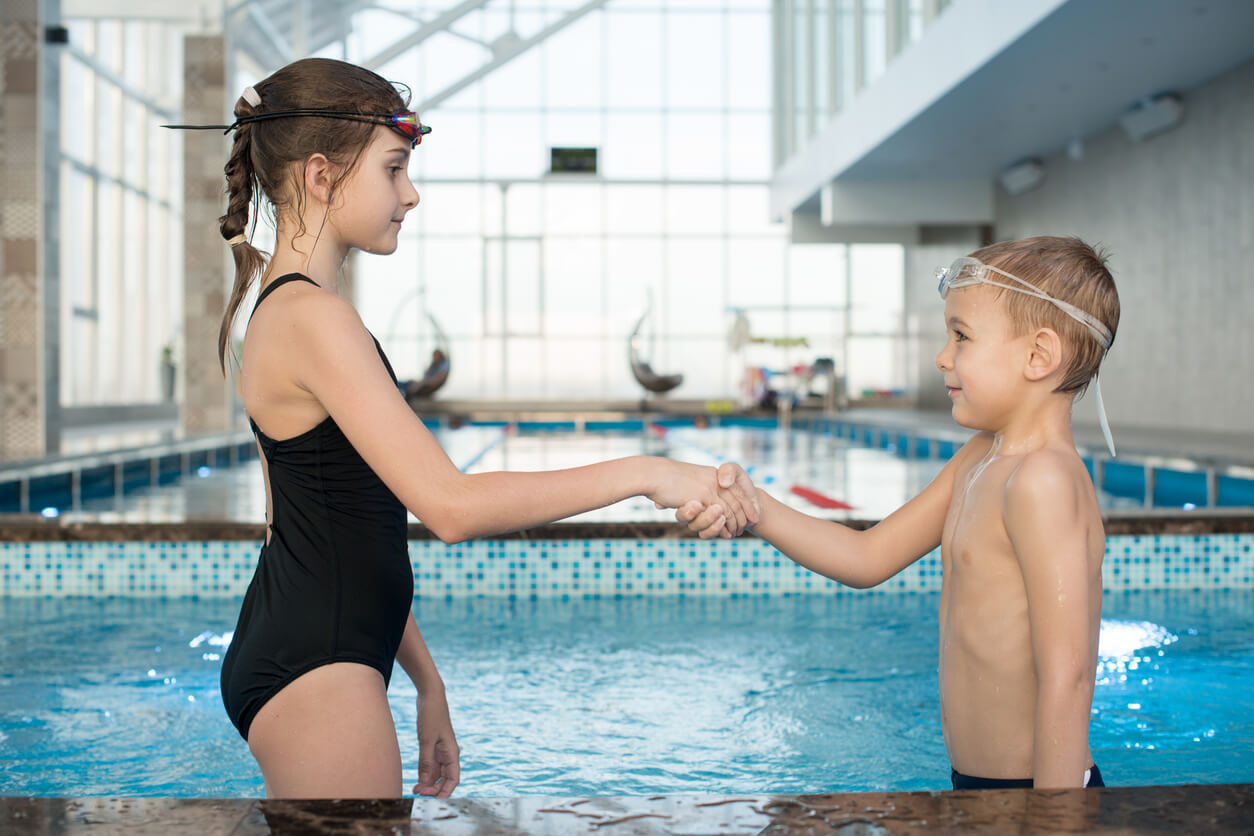Competitive Sports: How to Teach Children to Play Without Aggressiveness


Written and verified by degree in physical education and sports Andrés Felipe Cardona Lenis
Teaching children to play may seem contradictory, considering that play is the main learning tool for children. So why should we teach them? Besides the fact that they learn to play as such, what children should understand is that each sport has different rules. Also, that aggressiveness and excessive competitiveness have no place in any activity, whether it’s practiced for fun or in a sporting competition. In the following article, we’ll talk more about teaching children to play competitive sports without aggression.
Teaching children to play, sports, and childhood
Sports are extremely important for the physical and psychological development of human beings. In the childhood stage, they go hand in hand with play. That’s why you should pay close attention to the way in which your children carry them out.
During childhood, competitive sports are implemented through play in which the child plays with others of the same or similar ages. This scenario can lend itself to unhealthy or aggressive competition. Beyond the benefits it offers, it’s important that you supervise and perceive how your child carries them out. Remember that the practice should yield positive results, not negative ones.

Playing competitive sports without being aggressive
Children’s reactions to sports are often varied. Many of them are accompanied by aggressiveness, anger, and discomfort. Usually, this type of behavior is influenced by the example or upbringing they’ve had.
As a mother, you should pay excessive attention to this type of behavior, as it not only affects other children but also your own children. Aggressiveness can be evidenced through play and can even radiate into other environments. First of all, you should detect how the behavior is in relation to other children. If aggressiveness prevails, try to resort to dialogue and find out what the trigger for this type of situation is.
Is there stress in the game?
One of the main benefits of teaching children to play sports is the tranquility and the reduction in anxiety that physical activity offers. However, some sports practices can generate just the opposite in children. Therefore, being able to detect if excessive stress episodes are really triggered becomes relevant in order to be able to teach children to play in general.
It should be clarified that stress increases when performing any activity, both in children and adults. It helps to stay alert in decision-making situations. However, triggering excessive stress is harmful to the body. Therefore, if there’s stress during the sport, the important thing is that children control these levels so that it doesn’t become a problem.
Treat stress levels
Generally, stress levels are overflowing in children due to the pressure they feel. They take sport as a “life or death” competition and turn it into something supremely relevant where the only thing that matters is winning. This not only happens because of the child’s belief and perception of sports but also because of excessive pressure from coaches or parents.
An alternative is to turn to non-sporting activities in which your children are the main actors. For example, breathing management and walks in nature or other places of their liking can be of great help.
Also, try to teach them to manage a daily routine. It doesn’t matter if it has nothing to do with play or sports. For example, managing their homework on a scheduled basis can keep stress levels from rising significantly. Of course, it’s not about doing things like a robot, but about avoiding unexpected situations that generate stress.

Encourage sportsmanship
Teaching children to play sports without being aggressive can be summed up as encouraging sportsmanship. This means that little ones should learn to compete without seeing the sport for the sole purpose of victory. Beyond winning or losing, they must understand that both results are part of the competition and they need to learn to be able to handle both results.
Teach children to play competitive sports and learn with them
It’s logical that children must learn many things; that’s what life is all about. Especially at a stage when they’re just beginning to build habits and personality traits. However, adults also have the duty to learn how to educate their children. Therefore, try to see sports as a tool to push your knowledge and help your child. In the end, the learning will be mutually beneficial – you won’t regret it!
Teaching children to play may seem contradictory, considering that play is the main learning tool for children. So why should we teach them? Besides the fact that they learn to play as such, what children should understand is that each sport has different rules. Also, that aggressiveness and excessive competitiveness have no place in any activity, whether it’s practiced for fun or in a sporting competition. In the following article, we’ll talk more about teaching children to play competitive sports without aggression.
Teaching children to play, sports, and childhood
Sports are extremely important for the physical and psychological development of human beings. In the childhood stage, they go hand in hand with play. That’s why you should pay close attention to the way in which your children carry them out.
During childhood, competitive sports are implemented through play in which the child plays with others of the same or similar ages. This scenario can lend itself to unhealthy or aggressive competition. Beyond the benefits it offers, it’s important that you supervise and perceive how your child carries them out. Remember that the practice should yield positive results, not negative ones.

Playing competitive sports without being aggressive
Children’s reactions to sports are often varied. Many of them are accompanied by aggressiveness, anger, and discomfort. Usually, this type of behavior is influenced by the example or upbringing they’ve had.
As a mother, you should pay excessive attention to this type of behavior, as it not only affects other children but also your own children. Aggressiveness can be evidenced through play and can even radiate into other environments. First of all, you should detect how the behavior is in relation to other children. If aggressiveness prevails, try to resort to dialogue and find out what the trigger for this type of situation is.
Is there stress in the game?
One of the main benefits of teaching children to play sports is the tranquility and the reduction in anxiety that physical activity offers. However, some sports practices can generate just the opposite in children. Therefore, being able to detect if excessive stress episodes are really triggered becomes relevant in order to be able to teach children to play in general.
It should be clarified that stress increases when performing any activity, both in children and adults. It helps to stay alert in decision-making situations. However, triggering excessive stress is harmful to the body. Therefore, if there’s stress during the sport, the important thing is that children control these levels so that it doesn’t become a problem.
Treat stress levels
Generally, stress levels are overflowing in children due to the pressure they feel. They take sport as a “life or death” competition and turn it into something supremely relevant where the only thing that matters is winning. This not only happens because of the child’s belief and perception of sports but also because of excessive pressure from coaches or parents.
An alternative is to turn to non-sporting activities in which your children are the main actors. For example, breathing management and walks in nature or other places of their liking can be of great help.
Also, try to teach them to manage a daily routine. It doesn’t matter if it has nothing to do with play or sports. For example, managing their homework on a scheduled basis can keep stress levels from rising significantly. Of course, it’s not about doing things like a robot, but about avoiding unexpected situations that generate stress.

Encourage sportsmanship
Teaching children to play sports without being aggressive can be summed up as encouraging sportsmanship. This means that little ones should learn to compete without seeing the sport for the sole purpose of victory. Beyond winning or losing, they must understand that both results are part of the competition and they need to learn to be able to handle both results.
Teach children to play competitive sports and learn with them
It’s logical that children must learn many things; that’s what life is all about. Especially at a stage when they’re just beginning to build habits and personality traits. However, adults also have the duty to learn how to educate their children. Therefore, try to see sports as a tool to push your knowledge and help your child. In the end, the learning will be mutually beneficial – you won’t regret it!
All cited sources were thoroughly reviewed by our team to ensure their quality, reliability, currency, and validity. The bibliography of this article was considered reliable and of academic or scientific accuracy.
- García, F. G. (2001). El estres de los jovenes deportistas. XVIII Congreso Panamericano de Educación Física.
- Méndez-Giménez, A. (2010). El Aprendizaje Cooperativo, la Enseñanza Comprensiva y el modelo de Educación Deportiva: revisión de analogías, características e hibridaciones. VII Congreso Internacional de Actividades Físicas Cooperativas.
- Del Águila-Escobedo, A. (2016). Violencia y estrés infantil: ¿está en juego nuestro futuro? ACTA MEDICA PERUANA. https://doi.org/10.35663/amp.2015.322.132
This text is provided for informational purposes only and does not replace consultation with a professional. If in doubt, consult your specialist.








